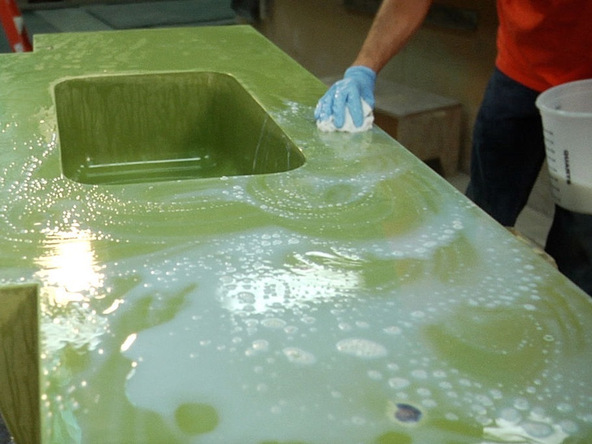Frequently asked waxing and sealing concrete countertops questions:

Q1: How do I remove CHENG Concrete Countertop Sealer from my concrete countertop?
If the sealer has been misapplied, or needs to be removed in order to refinish the countertop, use specially formulated CHENG Sealer Remover to dissolve the sealer followed by CHENG Surface Prep to remove all remnants of the sealer from the countertop.
Q2: How do I remove unsightly swirl marks and streaks from dried concrete countertop sealer?
In cases where the problem is excess sealer build-up or swirl marks, you should try burnishing the sealer with the Diamond Infused Burnishing Pads to see if this alleviates the problem before going through the process of stripping the sealer completely.
Q3: When and how do I apply CHENG Wax to my countertop?
For best results, your concrete countertop sealer should have a full hour cure before waxing. CHENG Concrete Countertop Wax is best applied with a moistened wax applicator in small sections. Since the CHENG Wax dries to a durable hard finish it is very important to buff the wax to a shine while it is still soft. Work in small areas and buff the wax immediately after applying to the concrete.
Q4: How many coats of wax do I apply? How long do I wait between coats?
For a brand-new countertop, we recommend three coats of wax in total. Two coats of wax should be applied prior to installation, and the third coat after installation, to remove any marks and scuffs resulting from installation. For maintenance, one coat applied once a month is recommended for lasting performance and beauty.
Q5: Why do you use a carnauba wax as opposed to beeswax?
Premium carnauba (like that in CHENG Concrete Countertop Wax) dries to a durable hard finish that is capable of withstanding rigorous daily use. Our experience with beeswax is that it’s less workable and never really dries, leaving a smeary and greasy appearance. In contrast, carnauba-based CHENG Wax is much easier to work with, dries to a hard finish and contains no harmful solvents that can soften the sealer beneath.
Q6: I am seeing some mild streaking from the sealing and am wondering what grit burnishing pads to work with?
Also, what would I do after burnishing? The wax buffer on my other tops didn’t seem to buff out evenly, again leaving uneven finish. Could the temperature be too cold in the work shop. 40 deg – 50 deg F?
First, your workshop temperature should not be a problem.These colder temperatures in fact would give you better working time with the sealer and give you better results. If you are having issues with sealer streaks, next time try to dilute the sealer with more water which will apply in thinner coats, but may lead to additional applications. Some people also find using a different applicator may give better results (like using a micro-fiber cloth rather than terry cloth).
As for the burnishing pads you will want an 800 & 1500 pad. Burnishing does remove sealer, so depending on how thick you have a film formed layer of sealer, you may actually burnish through it. Always start with the highest grit pad (1500) and if you find it is not removing the streaks move to the coarser one. Always wet your entire concrete piece after burnishing to see if you have “rubbed” through the sealer coats. If you see any dark areas forming, this is not a problem, you will just need to re-apply additional coats of sealer.
Wax Tips: Do not use a buffer to remove the applied wax. A wax buffer is only used to polish/gloss the applied wax after it has been applied and buffed off. The Cheng wax dries too quick and too hard to remove with a buffer. Use a wet applicator working in areas no larger than 12″ x 12″. Apply and then immediately rub off using a Terry Rag. A buffer can be used after you have completed the entire piece to bring is to a high luster.
